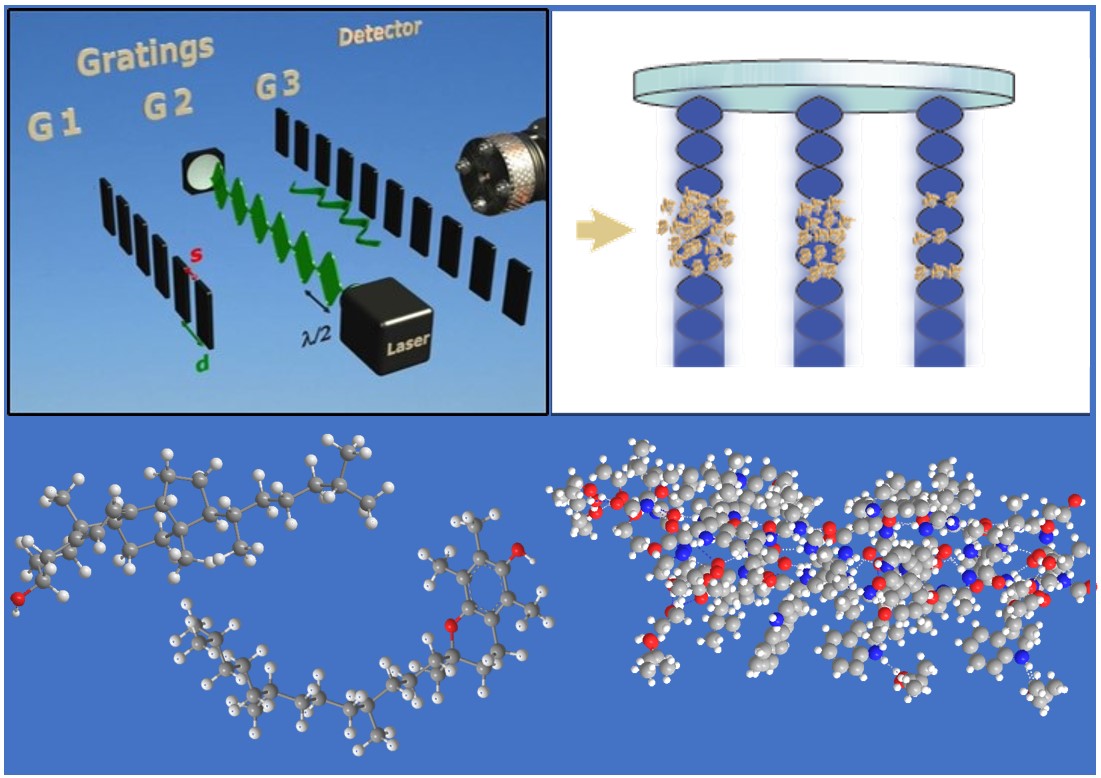Photophysics and magnetism in macromolecules
Photophysics and magnetism in macromolecules
Research question:
Bio/molecules in the gas phase are of interest, since they are isolated and solvent-free. Large neutral molecules have still been little explored but new methods in Vienna allow to transfer them into the gas phase, and even analyze them in quantum interference experiments. We will explore new methods to volatilize molecules to study their photophysics. Intense laser beams shall open the window to absorption and photo-isomerization on the single-molecule level in high vacuum and we will explore matter-wave-enhanced electric and magnetic deflectometry. Studies in a unique set of near-field molecule interferometers have already allowed us to utilize the quantum wave nature of thermal vitamins [1] and massive organic molecules up to about 27000 amu. Matter-wave interference imprints a nanoscale density pattern onto the molecular beam and this molecular nanoruler can be used to measure forces down to 10-26 Newton [3]. The absorption of even a single photon shifts the molecular fringe pattern measurably [4, 5] and it may induce electronic or structural changes in the molecule which lead to matter-wave fringe shifts in the presence of external electric or magnetic fields.

Methods:
Even large molecules can be evaporated in Knudsen cells, and fs-laser desorption will volatilize complex polypeptides even beyond the size of insulin. We will study diffraction and detection based on ionization and dissociation via photocleavage. Molecules in quantum superposition states shall be exposed to intense optical, electric and magnetic fields to shift their matter-wave fringes in proportion to intramolecular properties. The results shall be interpreted with support from advanced quantum chemistry and serve to gauge these models with new measurements.
Time frame:
Months 1-9: Exploration of molecular ground state magnetism; months 9-18: exploration of excited state magnetism; months 13-27: new sources for fragile molecules; months 28-42: new beam splitters for fragile molecules; months 43-48: writing of papers and thesis.
Participating DCAFM-faculty:
M. Arndt (PI), L. González (computational, photo-excitation and dynamics), C. Franchini (computational, magnetism), T. Pichler (training spectroscopy)
[1] L. Mairhofer, ..., M. Arndt, Angew. Chem. Int. Ed. 56, 10947 (2017), DOI: 10.1002/anie.201704916.
[2] M. Arndt. Phys. Tod. 67, 30-36 (2014), DOI: 10.1063/PT.3.2381.
[3] S. Eibenberger,...,M. Arndt, Phys. Rev. Lett. 112, 250402 (2014), DOI:10.1103/PhysRevLett.112.250402.
[4] J. Rodewald,..., M. Arndt, Appl. Phys. B 123, (2016), DOI: 10.1007/s00340-016-6573-y.
[5] L. Mairhofer, ..., M. Arndt, Entropy 20, 516 (2018), DOI: 10.3390/e20070516.
